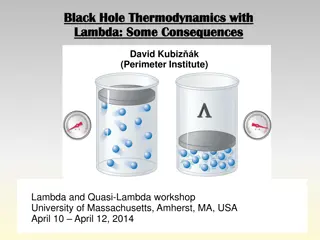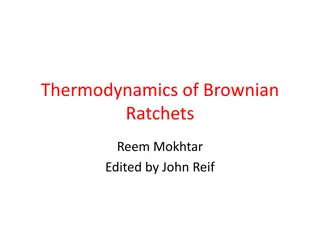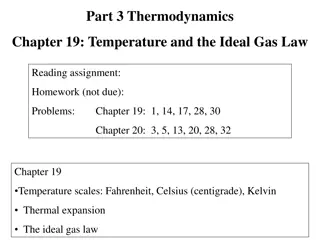Understanding Refrigerators and Second Law of Thermodynamics
Refrigerators are devices that transfer energy between low and high-temperature reservoirs using work. This process involves various thermodynamic cycles like the heat pump cycle and air conditioner cycle. The efficiency of refrigerators is described by the coefficient of performance, which is crucial for extracting energy efficiently. For Carnot refrigerators, the coefficient of performance is influenced by the temperature of the reservoirs.
Download Presentation

Please find below an Image/Link to download the presentation.
The content on the website is provided AS IS for your information and personal use only. It may not be sold, licensed, or shared on other websites without obtaining consent from the author. Download presentation by click this link. If you encounter any issues during the download, it is possible that the publisher has removed the file from their server.
E N D
Presentation Transcript
Thermal Physics Lecture 10 Dr.-Ing. Erwin Sitompul President University http://zitompul.wordpress.com 2 0 1 4 President University Erwin Sitompul Thermal Physics 10/1
Chapter 20 Second Law of Thermodynamics Entropy in the Real World: Refrigerators A refrigerator is a device that uses work to transfer energy from a low-temperature reservoir to a high-temperature reservoir as the device continuously repeats a series of thermodynamic processes. In a household refrigerator, for example, work is done by an electrical compressor to transfer energy from the food storage compartment ( a low-temperature reservoir) to the room (a high- temperature reservoir). Air conditioners and heat pumps are also refrigerators. The differences are only in the nature of the high- and low-temperature reservoirs. For an air conditioner, the room is the low-temperature reservoir. For a heat pump, the room is the high-temperature reservoir. In an ideal refrigerator, all processes are reversible and no wasteful energy transfers occur as a result of, say, friction and turbulence. President University Erwin Sitompul Thermal Physics 10/2
Chapter 20 Second Law of Thermodynamics Entropy in the Real World: Refrigerators 6 6 Heat Pump Cycle Air Conditioner Cycle 1. Compressor: increasing pressure increasing temperature, enabling phase change from vapor to liquid 2. Condenser: coils with tubing and many fins where condensation occurs 3. Evaporator: coils with tubing and many fins where evaporation occurs 4. Air handler: fan to circulate air 5. Reversing valve: switch between heat pump and air conditioner 6. Expansion valve: decreasing pressure decreasing temperature, enabling phase change from liquid to vapor President University Erwin Sitompul Thermal Physics 10/3
Chapter 20 Second Law of Thermodynamics Entropy in the Real World: Refrigerators The next figure shows the basic elements of an ideal refrigerator. Its operation is the reverse of how the Carnot engine operates. All the direction of energy transfers and work are reversed from those of a Carnot engine. We can call such an ideal refrigerator a Carnot refrigerator. The designer of a refrigerator would like to extract as much energy |QL| as possible from the low-temperature reservoir (what we want) for the least amount of work |W| (what we pay for). A measure of the efficiency of a refrigerator expressed by K, called the coefficient of performance: Q K W what we pay for what we want = = L Coefficient of Performance, Any Refrigerator President University Erwin Sitompul Thermal Physics 10/4
Chapter 20 Second Law of Thermodynamics Entropy in the Real World: Refrigerators For a Carnot refrigerator, the first law of thermodynamics gives |W| = |QH| |QL|. Thus, the last equation then becomes Q K Q Q T K T T = L H L Coefficient of Performance, Carnot Refrigerator = L H L For household refrigerators, K 5. By examining the equation, we can find out that the value of K is higher if the temperatures of the two reservoirs are closer to each other. President University Erwin Sitompul Thermal Physics 10/5
Chapter 20 Second Law of Thermodynamics Checkpoint You wish to increase the coefficient of performance of an ideal refrigerator. You can do so by (a) running the cold chamber at a slightly higher temperature, (b) running the cold chamber at a slightly lower temperature, (c) moving the unit to a slightly warmer room, or (d) moving it to a slightly cooler room. The magnitudes for the temperature changes are to be the same in all four cases. List the changes according to the resulting coefficients of performance, greatest first. (a), (d), (c), and (b) T = K L T T H L President University Erwin Sitompul Thermal Physics 10/6
Chapter 20 Second Law of Thermodynamics Class Group Assignments 1. The coefficient of performance of a household refrigerator is 5.2. The temperature of the room where the refrigerator is located is 28 C. Determine the lowest possible temperature inside the refrigerator? (a) 10.8 C (b) 15.7 C (c) 18.2 C (d) 20.5 C (e) 27.2 C 2. The thermal reservoirs of a Carnot heat pump are at 27 C and 57 C. If the heat pump is required to produce 100 kW heating effect, how much power does this pump consume? (a) 2.07 kW (b) 9.1 kW (c) 12.7 kW (d) 15.3 kW (e) 20.7 kW 3. A vessel containing 5 kg of water at 10 C is put into a refrigerator. The 100 W motor runs for 5 minutes to cool the liquid to the refrigerator s low temperature, 0 C. What is the COP of the refrigerator? (a) 5.7 (b) 4.6 (c) 6.9 (d) 7.2 (e) 3.6 President University Erwin Sitompul Thermal Physics 10/7
Chapter 20 Second Law of Thermodynamics Homework 10 1.(20-39) 2.(20-42) Deadline: Wednesday, 2 July 2014. Validation test will be conducted in the beginning of the class. President University Erwin Sitompul Thermal Physics 10/8























